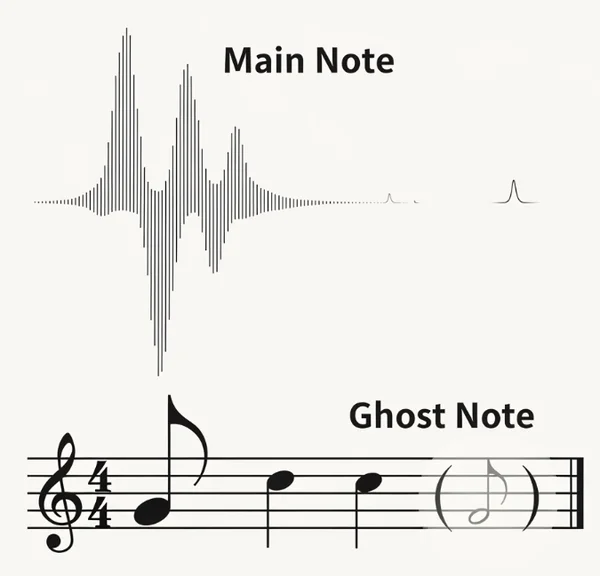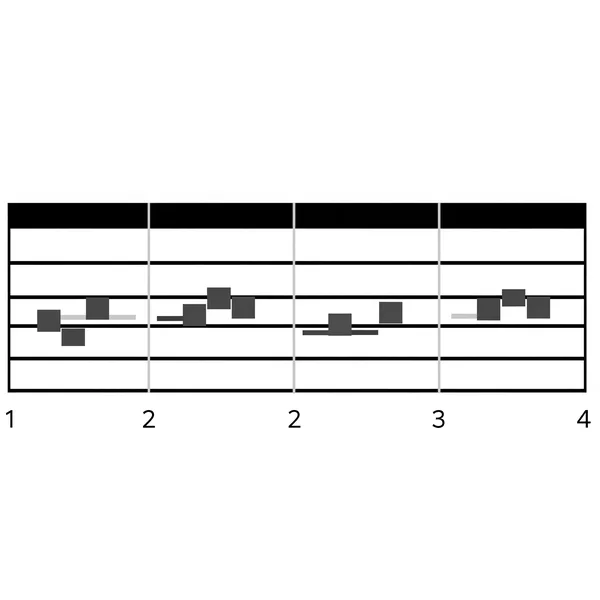掌握律动:进阶节拍器技巧
你是否想要提升你的音乐性,超越基本节奏?许多音乐家会遇到一个瓶颈,仅仅“踩准节拍”已经不够了。 如何提升我的节奏控制力? 并为我的演奏增添专业水准?本指南深入探讨了 高级节拍器技巧,特别是侧重于幽灵音符和错位拍,帮助你解锁更深层次的律动感和节奏细微差别。 通过适当的 节拍器练习 结合我们 免费在线节拍器 等多功能工具,你可以改变你对节奏的理解。
I. 导言:超越基本节拍——提升你的节奏控制
你可能已经用节拍器度过了无数小时,确保你的音符完美落在节拍上。 这是一个关键的基础。 但接下来是什么? 真正的节奏掌握不仅仅是准确性; 而是关于感觉、微妙之处以及以富有表现力的方式操纵时间的能力。 这就是 高级节拍器技巧 发挥作用的地方,帮助你 改善节奏细微之处,培养出一种复杂的 节奏控制 意识。 了解如何使用 在线节拍器 练习这些高级概念可以改变游戏规则。

II. 幽灵音符:通过进阶节拍器技巧增加律动深度
如何用节拍器练习幽灵音符? 幽灵音符是许多演奏者创造律动的秘诀,在不影响主要旋律或节奏想法的前提下,增加了质感和打击乐的感觉。
什么是幽灵音符?它们为何对律动至关重要?
幽灵音符是以更柔和的力度演奏的音符,几乎是耳语,你感觉到的比听到的更清晰。 它们填补了更突出的音符之间的空间,对放克、爵士、R&B 乃至摇滚等风格的 节奏感 和 律动 都大有裨益。 幽灵音符如何增强律动感? 它们创造了一种运动感,防止节奏听起来静止或机械。

设置你的在线节拍器以进行有效的幽灵音符练习
尽管我们的 在线节拍器 能提供清晰稳定的主拍,但幽灵音符的练习通常需要内化节奏的细分。 将你的节拍器设置为舒适的 速度。 你最初可能会使用它的子划分功能(例如,8 分音符或 16 分音符)来了解这些较柔和的音符的适合位置。 关键是让幽灵音符的音量远小于 在线节拍器 的主拍。 有效的 节拍器设置 对于 复杂节奏练习 至关重要。
幽灵音符练习:不同乐器的逐步实践
- 基本脉冲填充: 从你的
在线节拍器上的简单四分音符脉冲开始。 在第 2 拍,演奏你的主要音符,然后在第 3 拍之前尝试融入一个或两个非常柔和的幽灵音符。 - 16 分音符网格练习: 将你的节拍器设置为中等
每分钟节拍数,并想象一个 16 分音符网格。 在主要节拍(1、2、3、4)上演奏强音符,并尝试将幽灵音符放置在各种 16 分音符子划分上(例如,"e"、"&"、"a")。 我们的在线节拍器可以帮助你保持网格稳定。 - 乐器实战:
- 鼓手: 练习在主要底拍之间使用较轻的军鼓敲击或踩镲 "chicks"。
- 贝斯手/吉他手: 使用闷音弦或非常轻的拨弦/扫弦。
- 钢琴家: 运用非常轻的指尖触碰。
这些
节拍器练习有助于建立力度控制。
幽灵音符练习中的常见误区及规避方法
一个常见问题是: 涉及幽灵音符的复杂节奏,节拍器应如何设置? 一个错误是将幽灵音符演奏得太大声,使其与主要音符无法区分。 另一个是时值不一致。 使用你的 在线节拍器 来确保均匀性。 从慢速开始,并专注于力度差异。
III. 错位拍:通过节拍器提升节奏感
音乐中的错位拍是什么? 错位拍包括有意地将音符或重音从主要的、预期的节拍移开,从而创造出一种推动、拉动或切分感,为你的 节奏感 增添刺激和趣味。
理解错位拍:打破节拍框架
错位拍挑战了听众(和演奏者)的期望。 关键在于,旋律短语或节奏重音并非落在你的 在线节拍器 所提供的“1、2、3、4”拍上,而是落在“和”拍,甚至是主要节拍前后的16分音符细分上。 这是 律动节拍器技巧 的基石。

错位拍练习:在线节拍器的配置
在线节拍器能帮助练习错位拍等高级技巧吗? 当然可以。 虽然滴答声保持稳定,但你的工作是把音符放在那个滴答声的 周围。
- 弱拍重音: 使用我们的 在线节拍器 的重音功能(如果适用于子划分)或在精神上专注于重读像每个节拍的 "和" 这样的子划分。
- 静音拍练习: 将你的
在线节拍器设置为只在第 1 拍和第 3 拍,或第 2 拍和第 4 拍发声。 这迫使你内化缺失的节拍并感受空间,从而更容易准确地放置错位音符。 这些是针对节奏挑战的有效节拍器练习。
错位拍进阶练习,挑战你的节奏控制力
- 简单位移: 采用一个基本的 4 音符短语。 首先用你的
在线节拍器在节拍上演奏它。 然后,尝试将整个短语提前 1 个 8 分音符,或延迟 1 个 8 分音符开始,而节拍器的滴答声保持不变。 - 旋律错位: 将其应用于简单的旋律。 唱出或演奏一个熟悉的曲调,但故意改变其相对于节拍器的稳定
速度的节奏位置。 - 错位即兴: 一旦你觉得舒适,尝试即兴创作,同时有意识地将重要的音符放在错位拍上。 这需要很强的
节奏控制。
错位拍:如何增强乐句表现与节奏感
错位拍可以防止音乐听起来可预测或机械。 它们创造了一种更具对话性、更具活力,而且通常更适合跳舞的 律动练习。 它是 改善节奏细微之处 的关键要素。
IV. 进阶技巧的融合:幽灵音符与错位拍的结合应用
当您开始结合这些 高级节拍器技巧 时,真正的魔力就出现了。 想象一个放克贝斯线,带有幽灵音符填充 16 分音符空间,而主要重读音符经常错位,从而产生一种无法抗拒的律动。
节奏复杂度的叠加:一种整体方法
这涉及到高水平的 节奏控制 和意识。 首先,通过你的 在线节拍器 单独掌握幽灵音符和错位拍。 然后,选择一个简单的节奏模式,并尝试同时结合两者:也许是错位的主音符,然后是几个幽灵音符,通往下一个节拍。

组合高级练习:使用你的在线节拍器
将你的 在线节拍器 设置为清晰的脉冲。 如果它能帮助你绘制出幽灵音符所在的 16 分音符,你可能需要使用它的子划分功能。 挑战在于在那个稳定的参考下执行幽灵音符的力度变化和错位拍的节奏偏移。
实战范例:聆听这些技巧的应用
积极聆听放克(詹姆斯·布朗、议会-放克加利)、爵士、R&B 等流派的律动大师。 尝试识别他们在哪里使用幽灵音符和错位拍。 然后,尝试使用你的 在线节拍器 来复制这些感觉。
V. 通过进阶节拍器练习,提升演奏水平
使用 高级节拍器技巧 掌握幽灵音符和错位拍需要时间和专注的 节拍器练习,但回报是巨大的。 你的演奏将更具深度、律动感,并展现出独特的节奏复杂性。 这些 节拍器练习 旨在突破你的界限。
不要害怕在我们 免费且易于使用的在线节拍器 上尝试不同的 节拍器设置 和子划分。 增强 节奏控制 和更深刻的 节奏感 的旅程是值得的。 从今天开始,感受不同!
你最喜欢用 在线节拍器 进行高级练习的方式是什么? 在下面的评论中分享你的技巧和经验!
VI. 进阶节拍器技巧:常见问题
-
如何使用节拍器练习幽灵音符?
将你的
在线节拍器设置为稳定的速度。 专注于演奏比主要节拍明显更柔和的幽灵音符,通常将它们融入主要滴答声周围的 8 分音符或 16 分音符子划分中。 从慢速开始,并优先考虑力度对比和均匀时值。 -
音乐中的错位拍是什么?
错位拍是指有意地将音符或重音从主要的、预期的节拍中移开。 这会产生切分感,以及相对于稳定脉冲(通常由
在线节拍器在节拍器练习期间提供)的节奏推力或拉力感。 -
在线节拍器有哪些进阶练习?
是的! 除了基本时值之外,你还可以使用像 metronome.wiki 上的
在线节拍器来练习幽灵音符、错位拍、复节奏、度量调制,以及使用子划分或仅听到特定节拍来提高内部时值。 -
幽灵音符如何增加律动感?
幽灵音符用非常柔和的打击乐声音填补了节奏空间,增加了微妙的复杂性和运动。 这创造了一种更饱满、更“呼吸”的
节奏感,对整体律动练习有很大贡献。 -
在线节拍器对进阶技巧有帮助吗?
绝对可以。 一个好的
在线节拍器提供了稳定的节奏参考,这对于掌握高级节拍器技巧至关重要。 我们的平台 上的速度可调、拍号、清晰的每分钟节拍数显示等功能支持甚至复杂节奏练习。